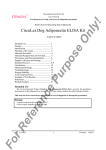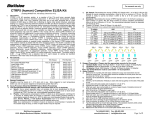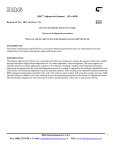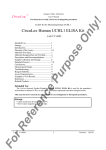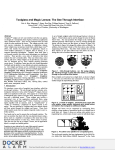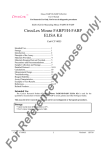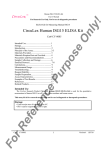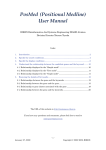Download For Reference Purpose Only!
Transcript
CircuLex Mouse Adiponectin ELISA Kit User’s Manual For Research Use Only, Not for use in diagnostic procedures ELISA Kit for Measuring Mouse Adiponectin On ly! TM CircuLex Mouse Adiponectin ELISA Kit Pu Intended Use................................................ 1 Storage......................................................... 1 Introduction.................................................. 2-3 Principle of the Assay.................................. 3-4 Materials Provided....................................... 4 Materials Required but not Provided........... 5 Precautions and Recommendations............. 6 Sample Collection and Storage.....................7 Detailed Protocol......................................... 8-9 Calculations.................................…............ 10 Measurement Range.................................... 10 Troubleshooting.......................................... 10 Reagent Stability......................................... 10-11 Assay Characteristics.................................. 11-13 Example of Test Results............................. 14 References................................................... 14 Related Products......................................... 15 rp os e Cat# CY-8051 ce Intended Use The CycLex Research Product CircuLex Mouse Adiponectin ELISA Kit is used for the quantitative measurement of mouse or rat adiponectin in serum, plasma, tissue culture medium and other biological media. en This assay kit is for research use only and not for use in diagnostic or therapeutic procedures. Storage rR ef er • Upon receipt store all components at 4°C. • Don’t expose reagents to excessive light. Fo Cat#: CY-8051 1 Version#: 120807 CircuLex Mouse Adiponectin ELISA Kit User’s Manual For Research Use Only, Not for use in diagnostic procedures On ly! TM Introduction ce Pu rp os e Adiponectin, also referred as Acrp30, AdipoQ and GBP-28, is a recently discovered 244 amino acid protein, the product of the apM1 gene, which is physiologically active and specifically and highly expressed in adipose cells (adipokine). The protein belongs to the soluble defense collagen superfamily; it has a collagen-like domain structurally homologous with collagen VIII and X and complement factor C1q-like globular domain (1, 2). Adiponectin forms homotrimers, which are the building blocks for higher order complexes found circulating in serum (3, 4). Circulating Adiponectin levels are high (5-30 g/mL), accounting for approximately 0.01% of total plasma protein (5-8). Adiponectin receptors AdipoR1 and AdipoR2 have been recently cloned; AdipoR1 is abundantly expressed in skeletal muscle, whereas AdipoR2 is predominantly expressed in the liver (9). Paradoxically, adipose tissue-expressed adiponectin levels are inversely related to the degree of adiposity (10,11). A reduction in adiponectin serum levels is accompanied by insulin resistance states, such as obesity and type 2 diabetes mellitus (12, 13). It is also reported in patients with coronary artery disease (13). Increased adiponectin levels are associated with type 1 diabetes mellitus, anorexia nervosa and chronic renal failure. Adiponectin concentrations correlate negatively with glucose, insulin, triglyceride concentrations and body mass index and positively with high-density lipoprotein-cholesterol levels and insulin-stimulated glucose disposal. Adiponectin has been shown to increase insulin sensitivity and decrease plasma glucose by increasing tissue fat oxidation. It inhibits the inflammatory processes of atherosclerosis suppressing the expression of adhesion and cytokine molecules in vascular endothelial cells and macrophages, respectively. This adipokine plays a role as a scaffold of newly formed collagen in myocardial remodeling after ischemic injury and also stimulates angiogenesis by promoting cross-talk between AMP-activated protein kinase and Akt signaling in endothelial cells (14). Injection of Adiponectin into non-obese diabetic mice leads to an insulin-independent decrease in glucose levels (15). This is likely due to insulin-sensitizing effects involving Adiponectin-regulation of triglyceride metabolism (15). A truncated form of Adiponectin (gAdiponectin) containing only the C-terminal globular domain has been identified in the blood, and recombinant gAdiponectin has been shown to regulate weight reduction as well as free fatty acid oxidation in mouse muscle and liver (16, 17). The full-length recombinant Adiponectin protein is apparently less potent at mediating these effects (16, 17). Principle of the Assay rR ef er en The CircuLex Mouse Adiponectin ELISA Kit employs the quantitative sandwich enzyme immunoassay technique. An antibody specific for mouse Adiponectin has been pre-coated onto a microplate. Standards and samples are pipetted into the wells and any Adiponectin present is bound by the immobilized antibody. After washing away any unbound substances, an HRP conjugated antibody specific for Adiponectin is added to the wells. Following a wash to remove any unbound antibody HRP conjugate, the remaining conjugate is allowed to react with the substrate H2O2-tetramethylbenzidine. The reaction is stopped by addition of acidic solution and absorbance of the resulting yellow product is measured at 450 nm. The absorbance is proportional to the concentration of Adiponectin. A standard curve is constructed by plotting absorbance values versus Adiponectin concentrations of calibrators, and concentrations of unknown samples are determined using this standard curve. The CircuLex Mouse Adiponectin ELISA Kit is designed to measure the concentration of mouse or rat adiponectin from mouse or rat serum/plasma, adipocytes, or conditioned medium. The principle of the assay is shown in below. Diluted samples and serially diluted standard (recombinant mouse adiponectin) solutions are added to an appropriate number of wells of the microtiter plate and incubated. Adiponectin in the sample will be bound by the primary anti-adiponectin antibody immobilized in the well (first reaction). After washing, the HRP-conjugated anti-adiponectin antibody is added to each well and allowed to incubate (second reaction). The HRP-conjugated anti-adiponectin antibody will bind to Fo Cat#: CY-8051 2 Version#: 120807 CircuLex Mouse Adiponectin ELISA Kit User’s Manual For Research Use Only, Not for use in diagnostic procedures On ly! TM the adiponectin trapped in the well in the first Reaction. After washing, the colorimetric substrate for the enzyme is added to all wells and incubated. The color development is terminated by the addition of a stop solution. The intensity of the color is measured at 450 nm. The concentrations of the samples tested are calculated using the absorbance values of the adiponectin standard solutions assayed at the same time. Summary of Procedure Add 100 µL of diluted sample to the wells rp os e Incubate for 1 hour at room temp. Wash the wells Add 100 µL of HRP conjugated anti-Adiponectin antibody Incubate for 1hour at room temp. Wash the wells Pu Add 100 µL of Substrate Reagent Add 100 µL of Stop Solution rR ef er en ce Measure absorbance at 450 nm Fo Cat#: CY-8051 3 Version#: 120807 CircuLex Mouse Adiponectin ELISA Kit User’s Manual For Research Use Only, Not for use in diagnostic procedures Materials Provided On ly! TM All samples and standards should be assayed in duplicate. The following components are supplied and are sufficient for the one 96-well microplate kit. Microplate: One microplate supplied ready to use, with 96 wells (12 strips of 8-wells) in a foil, zip-lock bag with a desiccant pack. Wells are coated with anti-mouse Adiponectin antibody as a capture antibody. 10X Wash Buffer: One 100 mL bottle of 10X buffer containing 2 %Tween®-20 rp os e Dilution Buffer: One bottle containing 50 mL each of 1X buffer; use for sample dilution. Ready to use. Mouse Adiponectin Standard: One vial containing 52.8 ng of lyophilized recombinant mouse Adiponectin HRP conjugated Detection Antibody: One vial containing 12 mL of HRP (horseradish peroxidase) conjugated anti-mouse Adiponectin antibody. Ready to use. Substrate Reagent: One bottle containing 20 mL of the chromogenic substrate, tetra-methylbenzidine (TMB). Ready to use rR ef er en ce Pu Stop Solution: One bottle containing 20 mL of 1 N H2SO4. Ready to use Fo Cat#: CY-8051 4 Version#: 120807 CircuLex Mouse Adiponectin ELISA Kit User’s Manual For Research Use Only, Not for use in diagnostic procedures On ly! TM Materials Required but not Provided • Pipettors: 2-20 µL, 20-200 µL and 200-1000 µL precision pipettors with disposable tips. • Precision repeating pipettor • Orbital microplate shaker • Microcentrifuge and tubes for sample preparation. rp os e • Vortex mixer • Microplate washer: optional (Manual washing is possible but not preferable) • Plate reader capable of measuring absorbance in 96-well plates at dual wavelengths of 450 nm/540 nm. Dual wavelengths of 450/550 or 450/595 nm can also be used. The plate can also be read at a single wavelength of 450 nm, which will give a somewhat higher reading. • Software package facilitating data generation and analysis :optional • Reagent reservoirs • Deionized water of the highest quality rR ef er en ce • Disposable paper towels Pu • 500 or 1000 mL graduated cylinder Fo Cat#: CY-8051 5 Version#: 120807 CircuLex Mouse Adiponectin ELISA Kit User’s Manual For Research Use Only, Not for use in diagnostic procedures Precautions and Recommendations • Allow all the components to come to room temperature before use. On ly! TM • All microplate strips that are not immediately required should be returned to the zip-lock pouch, which must be carefully resealed to avoid moisture absorption. • Do not use kit components beyond the indicated kit expiration date. rp os e • Use only the microtiter wells provided with the kit. • Rinse all detergent residue from glassware. • Use deionized water of the highest quality. • Do not mix reagents from different kits. • The buffers and reagents used in this kit contain NaN3 as preservatives. Care should be taken to avoid direct contact with these reagents. • Do not mouth pipette or ingest any of the reagents. Pu • Do not smoke, eat, or drink when performing the assay or in areas where samples or reagents are handled. • Dispose of tetra-methylbenzidine (TMB) containing solutions in compliance with local regulations. • Avoid contact with the acidic Stop Solution and Substrate Solution, which contains hydrogen peroxide. ce • Wear gloves and eye protection when handling immunodiagnostic materials and samples of mouse origin, and these reagents. In case of contact with the Stop Solution and the Substrate Solution, wash skin thoroughly with water and seek medical attention, when necessary. en • Biological samples might be contaminated with infectious agents. Do not ingest, expose to open wounds or breathe aerosols. Wear protective gloves and dispose of biological samples properly. rR ef er • CAUTION: Sulfuric Acid is a strong acid. Wear disposable gloves and eye protection when handling Stop Solution. Fo Cat#: CY-8051 6 Version#: 120807 CircuLex Mouse Adiponectin ELISA Kit User’s Manual For Research Use Only, Not for use in diagnostic procedures On ly! TM Sample Collection and Storage Serum: Allow blood samples to clot for 60 ± 30 minutes. Centrifuge the samples at 4°C for 10 minutes at 1,000 x g. Remove serum and assay immediately or store samples on ice for up to 6 hours before assaying. Aliquots of serum may also be stored at below -70°C for extended periods of time. Avoid repeated freeze-thaw cycles. rp os e Plasma: Collect plasma using EDTA-Na2 as the anticoagulant. If possible, collect the plasma into a mixture of EDTA-Na2 and Futhan5 to stabilize the sample against spontaneous in vitro complement activation. Immediately centrifuge samples at 4°C for 15 minutes at 1,000 x g. Assay immediately or store samples on ice for up to 6 hours before assaying. Aliquots of plasma may also be stored at below -70°C for extended periods of time. Avoid repeated freeze-thaw cycles. Note: Citrate plasma has not been validated for use in this assay. rR ef er en ce Pu Other biological samples: Remove any particulates by centrifugation and assay immediately or aliquot and store samples at below -70°C. Avoid repeated freeze-thaw cycles. Fo Cat#: CY-8051 7 Version#: 120807 CircuLex Mouse Adiponectin ELISA Kit User’s Manual For Research Use Only, Not for use in diagnostic procedures On ly! TM Detailed Protocol The CycLex Research Product CircuLex Mouse Adiponectin ELISA Kit is provided with removable strips of wells so the assay can be carried out on separate occasions using only the number of strips required for the particular determination. Since experimental conditions may vary, an aliquot of the Mouse Adiponectin Standard within the kit, should be included in each assay as a calibrator. Disposable pipette tips and reagent troughs should be used for all liquid transfers to avoid cross-contamination of reagents or samples. Preparation of Working Solutions rp os e All reagents need to be brought to room temperature prior to the assay. Assay reagents are supplied ready-to-use, with the exception of 10X Wash Buffer and Mouse Adiponectin Standard. 1. Prepare a working solution of Wash Buffer by adding 100 mL of the 10X Wash Buffer to 900 mL of deionized (distilled) water (ddH2O). Mix well. Store at 4°C for two weeks or -20°C for long-term storage. 2. Reconstitute Mouse Adiponectin Standard with 1.1 mL of ddH2O. The concentration of the mouse Adiponectin in vial should be 48 ng/mL, which is referred as a Master Standard of mouse Adiponectin. Pu Prepare Standard Solutions as follows: Use the Master Standard to produce a dilution series (below). Mix each tube thoroughly before the next transfer. The 12 ng/mL standard (Std.1) serves as the highest standard. The Dilution Buffer serves as the zero standard (Blank). Volume of Standard 150 µL of Master Standard 300 µL of Std. 1 (12.00 ng/ml) 300 µL of Std. 2 (6.00 ng/ml) 300 µL of Std. 3 (3.00 ng/ml) 300 µL of Std. 4 (1.50 ng/ml) 300 µL of Std. 5 (0.75 ng/ml) 300 µL of Std. 6 (0.38 ng/ml) en ce Std.1 Std.2 Std.3 Std.4 Std.5 Std.6 Std.7 Blank - Dilution Buffer 450 µL 300 µL 300 µL 300 µL 300 µL 300 µL 300 µL 300 µL Concentration 12.00 ng/mL 6.00 ng/mL 3.00 ng/mL 1.50 ng/mL 0.75 ng/mL 0.38 ng/mL 0.19 ng/mL 0 ng/mL er Note: Do not use a Repeating pipette. Change tips for every dilution. Wet tip with Dilution Buffer before dispensing. Unused portions of Standards should be aliquoted and stored at below -70°C immediately. Avoid multiple freeze and thaw cycles. ef Sample Preparation rR • Serum and plasma samples require a 2,500-fold dilution. e.g. First: Make 50-fold dilution (2 µL of sample + 98 µL of Dilution Buffer) Second: Make 2,500-fold dilution (5 µL of 50-fold diluted sample + 245 µL Dilution Buffer) Fo Cat#: CY-8051 8 Version#: 120807 CircuLex Mouse Adiponectin ELISA Kit User’s Manual For Research Use Only, Not for use in diagnostic procedures Assay Procedure On ly! TM 1. Remove the appropriate number of microtiter wells from the foil pouch and place them into the well holder. Return any unused wells to the foil pouch, refold, seal with tape and store at 4°C. 2. Dilute samples with Dilution Buffer. (See “Sample Preparation” above.) 3. Pipette 100 µL of Standard Solutions (Std1-Std7, Blank) and diluted samples in duplicates, into the appropriate wells. rp os e 4. Incubate the plate at room temperature (ca.25°C) for 1 hour, shaking at ca. 300 rpm on an orbital microplate shaker. 5. Wash 4-times by filling each well with Wash Buffer (350 µL) using a squirt bottle, multi-channel pipette, manifold dispenser or microplate washer*. 6. Add 100 µL of HRP conjugated Detection Antibody into each well. 7. Incubate the plate at room temperature (ca.25°C) for 1 hour, shaking at ca. 300 rpm on an orbital microplate shaker. Pu 8. Wash 4-times by filling each well with Wash Buffer (350 µL) using a squirt bottle, multi-channel pipette, manifold dispenser or microplate washer*. 9. Add 100 µL of Substrate Reagent. Avoid exposing the microtiter plate to direct sunlight. Covering the plate with e.g. aluminum foil is recommended. Return Substrate Reagent to 4°C immediately after the necessary volume is removed ce 10. Incubate the plate at room temperature (ca. 25°C) for 10-20 minutes, shaking at ca. 300 rpm on an orbital microplate shaker. The incubation time may be extended up to 30 minutes if the reaction temperature is below than 20°C. en 11. Add 100 µL of Stop Solution to each well in the same order as the previously added Substrate Reagent. er 12. Measure absorbance in each well using a spectrophotometric microplate reader at dual wavelengths of 450/540 nm. Dual wavelengths of 450/550 or 450/595 nm can also be used. Read the microplate at 450 nm if only a single wavelength can be used. Wells must be read within 30 minutes of adding the Stop Solution*. rR ef Note-1: Complete removal of liquid at each step is essential to good performance. After the last wash, remove any remaining Wash Buffer by aspirating or decanting. Invert the plate and blot it against clean paper towels. Note-2: Reliable standard curves are obtained when either O.D. values do not exceed 0.2 units for the blank (zero concentration), or 2.5 units for the highest standard concentration. The plate should be monitored at 5-minute intervals for approximately 30 minutes. Note-3: If the microplate reader is not capable of reading absorbance greater than the absorbance of the highest standard, perform a second reading at 405 nm. A new standard curve, constructed using the values measured at 405 nm, is used to determine Adiponectin concentration of off-scale samples. The readings at 405 nm should not replace the on-scale readings at 450 nm. Fo Cat#: CY-8051 9 Version#: 120807 CircuLex Mouse Adiponectin ELISA Kit User’s Manual For Research Use Only, Not for use in diagnostic procedures On ly! TM Calculations rp os e Average the duplicate readings for each standard, control, and sample and subtract the average zero standard optical density. Plot the optical density for the standards versus the concentration of the standards and draw the best curve. The data can be linearized by using log/log paper and regression analysis may be applied to the log transformation. To determine the Adiponectin concentration of each sample, first find the absorbance value on the y-axis and extend a horizontal line to the standard curve. At the point of intersection, extend a vertical line to the x-axis and read the corresponding Adiponectin concentration. If the samples have been diluted, the concentration read from the standard curve must be multiplied by the dilution factor. A. The dose-response curve of this assay fits best to a sigmoidal 5-parameter logistic equation. The results of unknown samples can be calculated with any computer program having a 5-parameter logistic function. It is important to make an appropriate mathematical adjustment to accommodate for the dilution factor. B. Most microtiter plate readers perform automatic calculations of analyte concentration. The calibration curve is constructed by plotting the absorbance (Y) of calibrators versus log of the known concentration (X) of calibrators, using the four-parameter function. Alternatively, the logit log function can be used to linearize the calibration curve (i.e. logit of absorbance (Y) is plotted versus log of the known concentration (X) of calibrators). Pu Measurement Range Troubleshooting ce The measurement range is 0.19 ng/mL to 12 ng/mL. Any sample reading higher than the highest standard should be diluted with Dilution Buffer in higher dilution and re-assayed. Dilution factors need to be taken into consideration in calculating the mouse adiponectin concentration. en 1. The Mouse Adiponectin Standard should be run in duplicate, using the protocol described in the Detailed Protocol. Incubation times or temperatures significantly different from those specified may give erroneous results. 2. Poor duplicates, accompanied by elevated values for wells containing no sample, indicate insufficient washing. If all instructions in the Detailed Protocol were followed accurately, such results indicate a need for washer maintenance. er 3. Overall low signal may indicate that desiccation of the plate has occurred between the final wash and addition of Substrate Reagent. Do not allow the plate to dry out. Add Substrate Reagent immediately after wash. ef Reagent Stability rR All of the reagents included in the CycLex Research Product CircuLex Mouse Adiponectin ELISA Kit have been tested for stability. Reagents should not be used beyond the stated expiration date. Upon receipt, kit reagents should be stored at 4°C, except the reconstituted Mouse Adiponectin Standard must be stored at below -70°C. Coated assay plates should be stored in the original foil bag sealed by the zip lock and containing a desiccant pack. Fo Cat#: CY-8051 10 Version#: 120807 CircuLex Mouse Adiponectin ELISA Kit User’s Manual For Research Use Only, Not for use in diagnostic procedures For Research Use Only, Not For Use in Diagnostic or Therapeutic procedures Assay Characteristics 1. Sensitivity On ly! TM rp os e The limit of detection (defined as such a concentration of Adiponectin giving absorbance higher than mean absorbance of blank* plus three standard deviations of the absorbance of blank: A blank + 3*SD blank) is better than 0.173 ng/ml of sample. * Dilution Buffer is pipetted into blank wells, and the microtiter plate is blanked on air. Eighty assays were evaluated and the minimum detectable dose (MDD) of Adiponectin ranged from 0.116 - 0.197 ng/mL. The mean MDD was 0.173 ng/mL. The MDD was determined by adding three standard deviations to the mean optical density value of twenty zero standard replicates and calculating the corresponding concentration. 2.5 Pu A450 2.0 1.5 ce 1.0 0.0 en 0.5 0 2 4 6 8 10 12 14 rR ef er mouse Adiponectin conc. (ng/ml) Fo Cat#: CY-8051 11 Version#: 120807 TM On ly! CircuLex Mouse Adiponectin ELISA Kit User’s Manual For Research Use Only, Not for use in diagnostic procedures 2. Specificity The antibodies in the CircuLex Mouse Adiponectin ELISA Kit are highly specific of mouse and rat Adiponectin, with no detectable cross-reactivity to other cytokines that may be present in mouse and rat serum. 3. Precision rp os e Intra-assay Precision (Precision within an assay) Three samples of known concentration were tested twelve times on one plate to assess intra-assay precision. • Intra-assay (Within-Run, n=12) A 20.85 21.93 22.34 20.34 21.29 22.14 23.24 22.19 22.94 20.28 20.59 21.20 23.24 20.28 21.61 1.00 4.6% ce Pu 1 2 3 4 5 6 7 8 9 10 11 12 MAX. MIN. MEAN S.D. C.V. mouse Adiponectin conc. (ug/ml) B C 10.55 13.45 9.69 14.17 10.47 13.98 10.29 14.22 10.56 14.27 10.49 13.77 10.41 13.69 9.67 14.44 9.82 13.48 9.76 13.53 9.88 13.32 9.84 13.30 10.56 14.44 9.67 13.30 10.12 13.80 0.37 0.40 3.6% 2.9% en Inter-assay Precision (Precision between assays) Three samples of known concentration were tested in six separate assays to assess inter-assay precision. • Inter-assay (Run-to-Run, n=6) rR ef er Day 1 2 3 4 5 6 MAX. MIN. MEAN S.D. C.V. Fo Cat#: CY-8051 A 7.34 7.09 7.31 7.39 6.86 7.20 7.39 6.86 7.20 0.197 2.74% mouse Adiponectin conc. (ug/ml) B C 14.42 21.65 13.60 22.90 12.78 20.85 12.91 21.21 13.36 21.40 13.61 22.47 14.42 22.90 12.78 20.85 13.45 21.75 0.591 0.786 4.40% 3.61% 12 Version#: 120807 CircuLex Mouse Adiponectin ELISA Kit User’s Manual For Research Use Only, Not for use in diagnostic procedures On ly! TM 4. Spiking Recover Serum samples were spiked with different amounts of Mouse Adiponectin and assayed. The recovery of Adiponectin spiked to levels throughout the range of the assay was evaluated. Sample Average % Recovery Range Cell culture media (n=4) 98.4 % 101.0 % 104.2 %, 93.6 % 108.7 % 100.4 %, 89.4 % 99.7 % 94.9 % A None 16.22 - + 15ug/ml 30.98 98.36 + 5ug/ml 21.28 101.03 + 2.5ug/ml 18.83 104.15 None 8.82 - + 15ug/ml 22.86 93.57 + 5ug/ml 14.26 108.74 + 2.5ug/ml 11.33 100.35 None 14.05 - + 15ug/ml 27.46 89.43 + 5ug/ml 19.03 99.69 + 2.5ug/ml 16.42 94.85 rp os e Average (ug/ml) Recovery rate (%) B Average (ug/ml) Recovery rate (%) C Pu Average (ug/ml) Recovery rate (%) 5. Linearity ce To assess the linearity of the assay, samples containing and/or spiked with high concentrations of Adiponectin were serially diluted with the Dilution Buffer to produce samples with values within the dynamic range of the assay. Linearity 7.5 5.0 en ● Serum A ▲ Serum B ◆ Serum C er mouse Adiponectin conc. (ng/ml) 10.0 ef 2.5 rR 0.0 Fo Cat#: CY-8051 0 1 2 3 4 5 6 Dilution ratio (/10,000) 13 Version#: 120807 CircuLex Mouse Adiponectin ELISA Kit User’s Manual For Research Use Only, Not for use in diagnostic procedures On ly! TM Example of Test Results Fig.1 Secretion of mouse adiponectin into culture medium during OP9 differentiation into adipocytes 125 100 75 50 25 0 0 2 4 6 rp os e mouse Adiponectin conc. (ng/ml) M easurement of mouse Adioponectin in OP9 cell Culture Cup. 8 10 12 14 Pu Days of differentiation References rR ef er en ce 1. Maeda, K. et al.(1996) Biochem. Biophys. Res. Commun. 221:286. 2. Kishore, U. and K.B. Reid (2000) Immunopharmacology 49:159. 3. Shapiro, L. and P.E. Scherer (1998) Curr. Biol. 8:335. 4. Nakano, Y. et al.(1996) J. Biochem. (Tokyo) 120:803. 5. Scherer, P.E. et al. (1995) J. Biol. Chem. 270:26746. 6. Fruebis, J. et al. (2001) Proc. Natl. Acad. Sci. USA 98:2005. 7. Berg, A.H. et al. (2002) Trends Endocrinol. Metab. 13:84. 8. Arita, Y. et al. (1999) Biochem. Biophys. Res. Commun. 257:79. 9. Yamauchi, T. et al.(2003) Nature 423:762. 10 Stefan, N. et al.(2002) J. Clin. Endocrinol. Metab. 87:4652. 11. Matsubara, M. et al.(2002) Eur. J. Endocrinol. 147:173. 12. .Weyer, C. et al. (2001) J. Clin. Endocrinol. Metab. 86:1930. 13. Hotta, K. et al. (2000) Arterioscler. Thromb. Vasc. Biol. 20:1595. 14. Tomas, E. et al.(2002) Proc. Natl. Acad. Sci. USA 99:16309. 15. Berg, A.H. et al.(2001) Nat. Med. 7:947. 16. Fruebis, J. et al. (2001) Proc. Natl. Acad. Sci. USA 98:2005. 17. Yamauchi, T. et al.(2001) Nat. Med. 7:941. Fo Cat#: CY-8051 14 Version#: 120807 CircuLex Mouse Adiponectin ELISA Kit User’s Manual For Research Use Only, Not for use in diagnostic procedures Related Products rp os e * CircuLex Rat Adiponectin ELISA Kit: Cat# CY-8049 * CircuLex Human Adiponectin ELISA Kit: Cat# CY-8050 * CircuLex Mouse Adiponectin ELISA Kit: Cat# CY-8051 * CircuLex Dog Adiponectin ELISA Kit: Cat# CY-8052 * Anti-Human Adiponectin: Cat# CY-P1017 * Anti-Mouse Adiponectin: Cat# CY-P1018 * Anti-Human Adiponectin (17-36 aa): Cat# CY-P1031 On ly! TM PRODUCED BY Pu CycLex Co., Ltd. 1063-103 Terasawaoka Ina, Nagano 396-0002 Japan Fax: +81-265-76-7618 e-mail: [email protected] URL: http://www.cyclex.co.jp rR ef er en ce CycLex/CircuLex products are supplied for research use only. CycLex/CircuLex products and components thereof may not be resold, modified for resale, or used to manufacture commercial products without prior written approval from CycLex Co., Ltd.. To inquire about licensing for such commercial use, please contact us via email. Fo Cat#: CY-8051 15 Version#: 120807
















